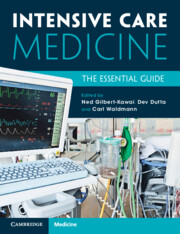Book contents
- Intensive Care Medicine
- Intensive Care Medicine
- Copyright page
- Dedication
- Dedication
- Epigraph
- Contents
- Contributors
- Preface
- Foreword
- Abbreviations
- Section 1 Resuscitation and Management of the Acutely Ill Patient
- Section 2 Diagnosis, Assessment, Investigation, Monitoring and Data Interpretation
- Domain 3 Disease Management: Recognition, Causes and Management
- Section 4 Therapeutic Interventions and Organ Support
- Domain 5 Practical Procedures
- Section 6 Perioperative Care
- Introduction
- Risk Scoring and ICU Triage
- Pre-optimisation/Prehabilitation
- Intraoperative Care
- Perioperative Fluid Management
- Post-operative Care
- Evidence for Intensive Care in High-Risk Surgical Patients
- Conclusion
- Introduction
- Handover
- Examination
- Investigations in the Post-operative Setting
- Introduction
- Criteria for CCU Admission Following Craniotomy
- Interventions Requiring CCU Admission
- Complications Requiring CCU Admission
- Pain Management
- Conclusion
- Introduction
- Cardiovascular
- Renal Failure
- Hepatorenal Syndrome
- Ventilation
- Allograft Function
- Infection
- Nutrition
- Post-operative Complications in the ICU
- Introduction
- Monitoring
- Haemodynamics
- Right Ventricular Failure
- Rate and Rhythm
- Fluids and Renal Function
- Bleeding
- Immunosuppression and Infection
- Acute Rejection
- Non-cardiac Surgery in Heart Transplant Patients
- Introduction
- Surgery and Monitoring
- Management after Lung Transplant
- Complications after Lung Transplant
- Introduction
- Severity of Injury
- Problems and Treatment Strategies in the ICU
- Introduction
- Multi-modal, Opioid-Sparing Analgesia
- Effective Circulating Volume/Adequate Resuscitation
- Addressing the Need for Anti-microbial Treatment
- Nutritional Support
- Prophylaxis against ICU Complications
- Abdominal Catastrophes
- 6.1 Management of Pre- and Post-operative Care of the High-Risk Surgical Patient
- 6.2 Management of the Critical Care Patient Following Cardiac Surgery
- 6.3 Management of the Critical Care Patient Following Craniotomy
- 6.4 Management of the Critical Care Patient Following Liver Transplant
- 6.5 Management of the Critical Care Patient Following Heart Transplant
- 6.6 Management of the Critical Care Patient Following Lung Transplant
- 6.7 Pre- and Post-operative Management of the Critical Care Trauma Patient
- 6.8 Management of the Critical Care Patient Following Major Abdominal Surgery
- Section 7 Comfort and Recovery
- Section 8 End-of-Life Care
- Section 9 Paediatric Care
- Section 10 Transport
- Section 11 Professionalism, Patient Safety, Governance and Health Systems Management
- Index
- References
6.7 - Pre- and Post-operative Management of the Critical Care Trauma Patient
from Section 6 - Perioperative Care
Published online by Cambridge University Press: 27 July 2023
- Intensive Care Medicine
- Intensive Care Medicine
- Copyright page
- Dedication
- Dedication
- Epigraph
- Contents
- Contributors
- Preface
- Foreword
- Abbreviations
- Section 1 Resuscitation and Management of the Acutely Ill Patient
- Section 2 Diagnosis, Assessment, Investigation, Monitoring and Data Interpretation
- Domain 3 Disease Management: Recognition, Causes and Management
- Section 4 Therapeutic Interventions and Organ Support
- Domain 5 Practical Procedures
- Section 6 Perioperative Care
- Introduction
- Risk Scoring and ICU Triage
- Pre-optimisation/Prehabilitation
- Intraoperative Care
- Perioperative Fluid Management
- Post-operative Care
- Evidence for Intensive Care in High-Risk Surgical Patients
- Conclusion
- Introduction
- Handover
- Examination
- Investigations in the Post-operative Setting
- Introduction
- Criteria for CCU Admission Following Craniotomy
- Interventions Requiring CCU Admission
- Complications Requiring CCU Admission
- Pain Management
- Conclusion
- Introduction
- Cardiovascular
- Renal Failure
- Hepatorenal Syndrome
- Ventilation
- Allograft Function
- Infection
- Nutrition
- Post-operative Complications in the ICU
- Introduction
- Monitoring
- Haemodynamics
- Right Ventricular Failure
- Rate and Rhythm
- Fluids and Renal Function
- Bleeding
- Immunosuppression and Infection
- Acute Rejection
- Non-cardiac Surgery in Heart Transplant Patients
- Introduction
- Surgery and Monitoring
- Management after Lung Transplant
- Complications after Lung Transplant
- Introduction
- Severity of Injury
- Problems and Treatment Strategies in the ICU
- Introduction
- Multi-modal, Opioid-Sparing Analgesia
- Effective Circulating Volume/Adequate Resuscitation
- Addressing the Need for Anti-microbial Treatment
- Nutritional Support
- Prophylaxis against ICU Complications
- Abdominal Catastrophes
- 6.1 Management of Pre- and Post-operative Care of the High-Risk Surgical Patient
- 6.2 Management of the Critical Care Patient Following Cardiac Surgery
- 6.3 Management of the Critical Care Patient Following Craniotomy
- 6.4 Management of the Critical Care Patient Following Liver Transplant
- 6.5 Management of the Critical Care Patient Following Heart Transplant
- 6.6 Management of the Critical Care Patient Following Lung Transplant
- 6.7 Pre- and Post-operative Management of the Critical Care Trauma Patient
- 6.8 Management of the Critical Care Patient Following Major Abdominal Surgery
- Section 7 Comfort and Recovery
- Section 8 End-of-Life Care
- Section 9 Paediatric Care
- Section 10 Transport
- Section 11 Professionalism, Patient Safety, Governance and Health Systems Management
- Index
- References
Summary
Key Learning Points
1. Patients are likely to have disturbances of acid–base balance, temperature, coagulation and haemodynamics on arrival.
2. Damage control surgery may be required to stabilise patients.
3. Care in the intensive care unit should centre around preventing secondary insult such as sepsis, venous thromboembolism, secondary brain injury and multi-organ failure.
4. The clinician may need to balance the mean arterial pressure between achieving adequate cerebral perfusion and avoiding further bleeding.
5. Patients are at significant risk of acute lung injury.
- Type
- Chapter
- Information
- Intensive Care MedicineThe Essential Guide, pp. 645 - 647Publisher: Cambridge University PressPrint publication year: 2021

